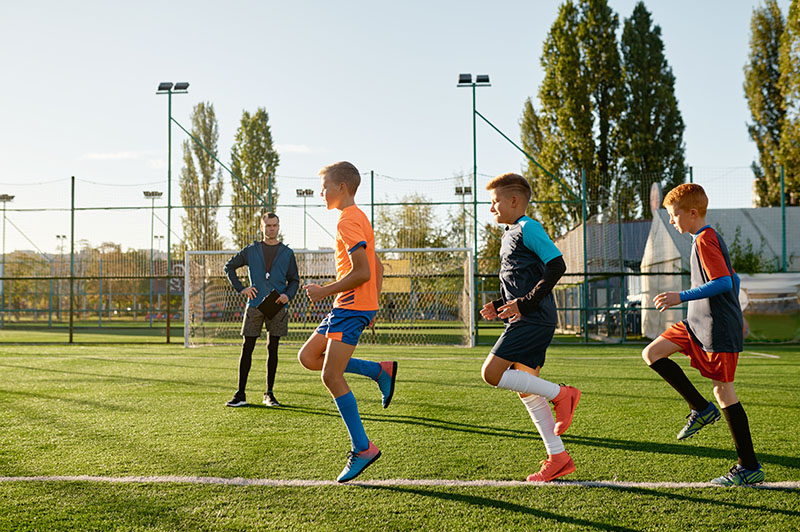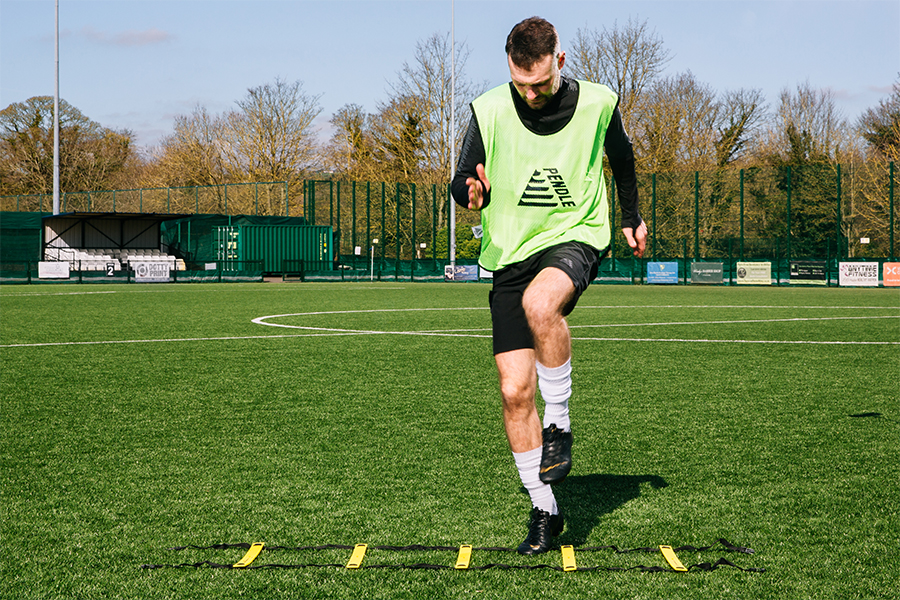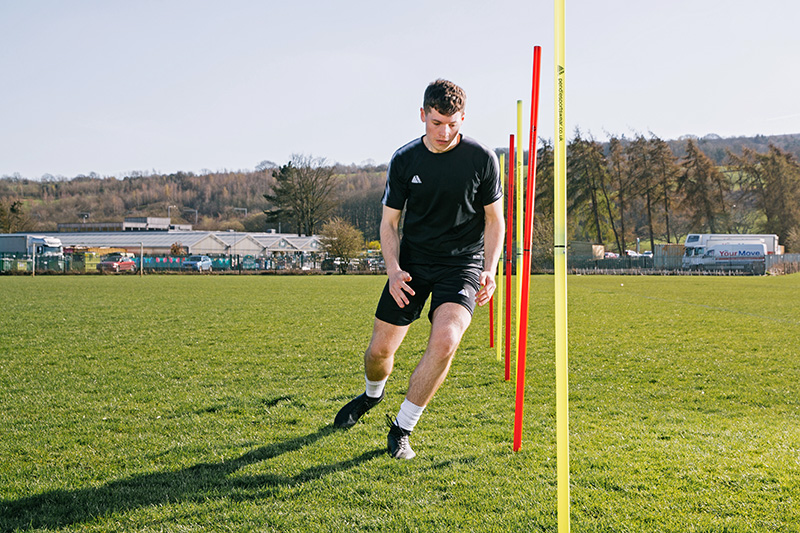Last Updated on: 17th September 2024, 09:48 am
Football Warm-Up
What is the RAMP warm-up protocol?
Warming up is an essential part of football all year round but it’s especially important in winter. Not only does it take longer, but your body has to work harder in cold weather. Getting adequately prepared means you’ll also reduce the risk of injury. So, you’ll be safer when those tumbles occur on a wet or icy pitch. But what is the best way to get your body ready for your next training session or match?
 The importance of a good warm-up
The importance of a good warm-up
We can’t overstate the importance of an effective warm-up whatever physical activity you’re about to do. All players should be warming up before any football match or training session. A proper warm-up can:
- Reduce the risk of injury
- Increase the body’s range of motion
- Increase body temperature
- Activate the cardiovascular and respiratory system
- Improve focus
You need to gradually increase your heart rate and blood circulation. This means your cardiovascular system will be able to transport and deliver the nutrients you need. It’s really important to stretch your muscles so they are ready for further exercise. Put too much pressure on a cold muscle and you risk injuries like cramps, sprains, or worse. Mentally, a warm-up gives you time to clear your head and get ready for the match or training session.
What is the RAMP warm-up?
The RAMP warm-up was developed by Ian Jeffrey and is considered one of the most effective warm-ups for athletes. RAMP stands for:
- Raise – Increase temperature, blood flow, muscle elasticity, and neural activity.
- Activate – Engage the muscles.
- Mobilise – Focus on movement patterns that will be used in the game/training session
- Potentiate – Gradually increase the stress on your body
The RAMP method gradually increases the intensity to create an effective and comprehensive warm-up.
What makes RAMP different?
Ian Jeffreys knows that time is key for player development. He believes that the warm-up should contribute to enhancing athletic performance. To optimise your time, you should be looking at how your warm-up can aid development.
When devising a RAMP warm-up, coaches should consider the short-term, medium-term, and long-term aims of a player’s development. So, you’re not only thinking about preparing players for one game or training session. Instead, you’re helping them reach their future goals. This approach ensures that all of your training time is spent aiding development and progress.
Raise
This phase is about getting your body ready for whatever you’re about to do. Whether this is a match or a training session, you need to be prepared. This includes increasing the following:
- Blood flow
- Muscle temperature
- Core temperature
- Muscle elasticity
- Quality of neural activation and conduction
The main goal for this phase is to get your core temperature up and increase blood flow. Your breathing rate will also increase so you get the energy you need. This is achieved through the targeted use of low-intensity movements.
You might be used to doing a few laps of the pitch before your training session but that doesn’t really replicate in-game conditions. Football is all about multi-directional movement, so you’ll be stopping, starting, turning, and jumping. Try to mimic this during the raise phase.
Raise Activities
This phase should be dedicated to movement and skill development. All of the preparation carried out during this part of your warm-up should be relevant to the sporting activity being performed.
- Movement development: focus on broad movements that resemble the ones used on the pitch. Think about acceleration, changing directing, changing speed, and reaction times.
- Skill development: use core skills that will help on the pitch. Start with low-intensity activities and slowly work your way up.
Activate and Mobilise
You’ll be concerned with two main aims during this phase of your warm-up: activating key muscle groups and mobilising key joints. This is done by taking them through a large range of motion. This phase needs to keep building on the raising that you started in the previous phase. This means a move away from traditional static stretching because it gives the body time to cool down.
Instead, it would be better to incorporate dynamic movements that focus on mobilisation and not flexibility. You need to actively move the joint through the kind of movements and motions that you will need during a game.
Activation and Mobilisation Activities
It’s all about incorporating dynamic movement into your stretches. No more standing and stretching your hamstring for 30 seconds. Why not perform 10 forward straight leg kicks instead? This will activate and mobilise the hamstring in a more dynamic way.
Potentiate
Potentiate means to make effective or active. This phase is about enhancing neuromuscular function and preparing the body for the specific demands of an upcoming activity. As important as the previous two phases are, they don’t prepare you for explosive and high-force performances on the pitch. To do this, you need an increase in the intensity of activity so you can gradually progress up to maximal effort.
You can carry out this phase in several different ways depending on what your players are preparing for. Before a match, use this phase as a rehearsal of the activities a player will perform on the pitch. Before training, you can use it as preparation for the session, as a training drill, or as a mixture of the two.
Potentiate Activities
You’ll want to plan some sport-specific activities that gradually increase in intensity. This phase is about the progression of specific movements or skills so it’s a good opportunity for some speed and agility training. Alternatively, have your players work through a series of plyometric training exercises that get progressively more intense.
Should I use RAMP in my football warm-up?
The basic theory of Ian Jeffreys’ protocol makes a lot of sense. It delivers in terms of utilising your time effectively and focusing on future development. It can also be adapted to suit the individual needs of your players. Depending on the long-term aims of your players, you can set targets that will help them the most.
The RAMP protocol offers a basic framework for structuring your warm-up. Following it will help your players prepare to go into high-intensity drills and potentially reduce the risk of injury. At a basic level, focusing on dynamic movement and stretches is sound advice for all players. It will help get their mind and body ready for training or a match.
Ramp Up Your Training and Your Training Wear
It’s not just your body and mind that needs to get ready for training. Make sure you’ve got all of the training wear you need to get the most out of your sessions. We have a great selection of items that are perfect for training at any time of the year. Pick up our winter essentials or some cooler options for summer.
The Braga training top is part of our slim-fit compression training wear. Combine with the Braga training bottoms and you’ve got the perfect training outfit. Alternatively, you can browse our range of training tops and add a matching pair of shorts. Slip on a base layer and base layer bottoms when it gets a bit colder. When it gets really cold, grab a pair of our Metz player gloves so you’re still able to grab the ball.
Pendle Recommendations
Tags: football, football coaching, Football training, football warm-up, RAMP warm-up, warm-up





